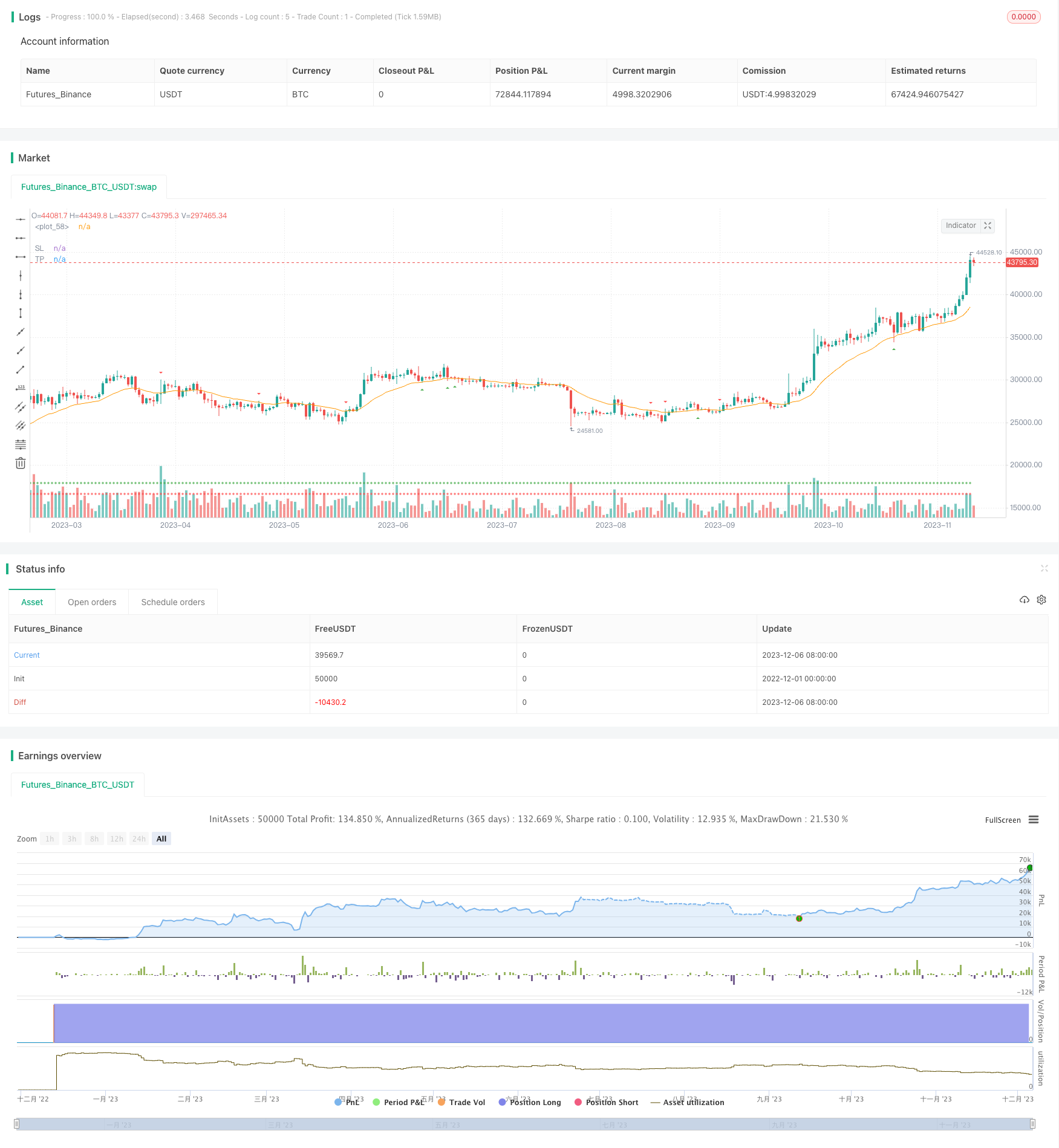
策略概述
移动平均线反弹策略是一种跟踪价格突破移动平均线的策略。它检查蜡烛是否从移动平均线下方反弹回来,如果是,就是多头信号;如果蜡烛从移动平均线上方向下反弹,就是空头信号。
策略名称
Exponential Moving Average Bounce Strategy
策略原理
该策略基于 exponential moving average (指数移动平均线)。它会实时计算出一个 EMA 线。然后检查价格是否从 EMA 线上方或下方发生反弹:
- 如果价格先跌破 EMA 线,然后又重新回升收盘于 EMA 线之上,就是多头信号
- 如果价格先突破 EMA线,然后又重新下跌收盘于EMA线之下,就是空头信号
这样的反弹就是策略的入场信号。
策略优势分析
顺势操作,避免被套
EMA反弹策略只在确定价格反转后才入场,能够避免逆势操作被套。
回撤小,历史收益好
由于运用了指数移动平均线,能够有效平滑价格数据,过滤市场噪音,使得该策略回撤小,历史收益较好。
容易理解,参数调整灵活
EMA反弹策略仅仅依赖移动平均线,非常简单直接,新手容易理解;同时EMA周期参数可以灵活调整,适应不同品种。
风险分析
容易假信号
EMA线附近往往存在密集的假突破,可能引发错误信号。需要调整EMA参数以过滤这些噪音。
顺势操作,无法预测转折点
该策略本质上是顺势操作。无法预测价格转折点,只能追逐趋势。这可能错过周期调整的最佳入场时机。
止损位置容易被击穿
移动平均线附近的止损位有时候会被突破,造成亏损扩大。这需要运用更为灵活的止损方式。
优化方向
结合其他指标过滤信号
可以加入像RSI,MACD等其他指标来确认价格反转,过滤假信号。
优化止损方式
可以使用时间止损,震荡止损等更为灵活的止损方式,降低被击穿风险。
参数优化
对EMA周期参数进行优化,找到最佳参数组合。也可以使EMA参数动态变化,追踪市场周期。
总结
移动平均线反弹策略是一种简单实用的趋势跟踪策略。它顺势操作,回撤小,容易理解。同时也存在一定的假信号风险与止损风险。我们可以通过更好的指标组合,止损方式,参数选择来优化该策略,使其成为稳定可靠的量化策略。
策略源码
/*backtest
start: 2022-12-01 00:00:00
end: 2023-12-07 00:00:00
period: 1d
basePeriod: 1h
exchanges: [{"eid":"Futures_Binance","currency":"BTC_USDT"}]
*/
// This source code is subject to the terms of the Mozilla Public License 2.0 at https://mozilla.org/MPL/2.0/
// © tweakerID
// Simple strategy that checks for price bounces over an Exponential Moving Average. If the CLOSE of the candle bounces
// back from having it's LOW below the EMA, then it's a Bull Bounce. If the CLOSE of the candle bounces down from having it's
// high above the EMA, then it's a Bear Bounce. This logic can be reverted.
//@version=4
strategy("EMA Bounce", overlay=true,
default_qty_type=strategy.percent_of_equity,
default_qty_value=100,
initial_capital=10000,
commission_value=0.04,
calc_on_every_tick=false,
slippage=0)
direction = input(0, title = "Strategy Direction", type=input.integer, minval=-1, maxval=1)
strategy.risk.allow_entry_in(direction == 0 ? strategy.direction.all : (direction < 0 ? strategy.direction.short : strategy.direction.long))
/////////////////////// STRATEGY INPUTS ////////////////////////////////////////
title1=input(true, "-----------------Strategy Inputs-------------------")
i_EMA=input(20, title="EMA Length")
/////////////////////// BACKTESTER /////////////////////////////////////////////
title2=input(true, "-----------------General Inputs-------------------")
// Backtester General Inputs
i_SL=input(true, title="Use Swing Stop Loss and Take Profit")
i_SPL=input(defval=10, title="Swing Point Loopback")
i_PercIncrement=input(defval=.2, step=.1, title="Swing Point SL Perc Increment")*0.01
i_TPRRR = input(1.2, step=.1, title="Take Profit Risk Reward Ratio")
// Bought and Sold Boolean Signal
bought = strategy.position_size > strategy.position_size[1]
or strategy.position_size < strategy.position_size[1]
// Price Action Stop and Take Profit
LL=(lowest(i_SPL))*(1-i_PercIncrement)
HH=(highest(i_SPL))*(1+i_PercIncrement)
LL_price = valuewhen(bought, LL, 0)
HH_price = valuewhen(bought, HH, 0)
entry_LL_price = strategy.position_size > 0 ? LL_price : na
entry_HH_price = strategy.position_size < 0 ? HH_price : na
tp=strategy.position_avg_price + (strategy.position_avg_price - entry_LL_price)*i_TPRRR
stp=strategy.position_avg_price - (entry_HH_price - strategy.position_avg_price)*i_TPRRR
/////////////////////// STRATEGY LOGIC /////////////////////////////////////////
EMA=ema(close, i_EMA)
LowAboveEMA=low > EMA
LowBelowEMA=low < EMA
HighAboveEMA=high > EMA
HighBelowEMA=high < EMA
BullBounce=LowAboveEMA[1] and LowBelowEMA and close > EMA //and close > open
BearBounce=HighBelowEMA[1] and HighAboveEMA and close < EMA //and close < open
plot(EMA)
BUY=BullBounce
SELL=BearBounce
//Inputs
DPR=input(false, "Allow Direct Position Reverse")
reverse=input(false, "Reverse Trades")
// Entries
if reverse
if not DPR
strategy.entry("long", strategy.long, when=SELL and strategy.position_size == 0)
strategy.entry("short", strategy.short, when=BUY and strategy.position_size == 0)
else
strategy.entry("long", strategy.long, when=SELL)
strategy.entry("short", strategy.short, when=BUY)
else
if not DPR
strategy.entry("long", strategy.long, when=BUY and strategy.position_size == 0)
strategy.entry("short", strategy.short, when=SELL and strategy.position_size == 0)
else
strategy.entry("long", strategy.long, when=BUY)
strategy.entry("short", strategy.short, when=SELL)
SL=entry_LL_price
SSL=entry_HH_price
TP=tp
STP=stp
strategy.exit("TP & SL", "long", limit=TP, stop=SL, when=i_SL)
strategy.exit("TP & SL", "short", limit=STP, stop=SSL, when=i_SL)
/////////////////////// PLOTS //////////////////////////////////////////////////
plot(strategy.position_size > 0 ? SL : na , title='SL', style=plot.style_cross, color=color.red)
plot(strategy.position_size < 0 ? SSL : na , title='SSL', style=plot.style_cross, color=color.red)
plot(strategy.position_size > 0 ? TP : na, title='TP', style=plot.style_cross, color=color.green)
plot(strategy.position_size < 0 ? STP : na, title='STP', style=plot.style_cross, color=color.green)
// Draw price action setup arrows
plotshape(BUY ? 1 : na, style=shape.triangleup, location=location.belowbar,
color=color.green, title="Bullish Setup", transp=80, size=size.auto)
plotshape(SELL ? 1 : na, style=shape.triangledown, location=location.abovebar,
color=color.red, title="Bearish Setup", transp=80, size=size.auto)